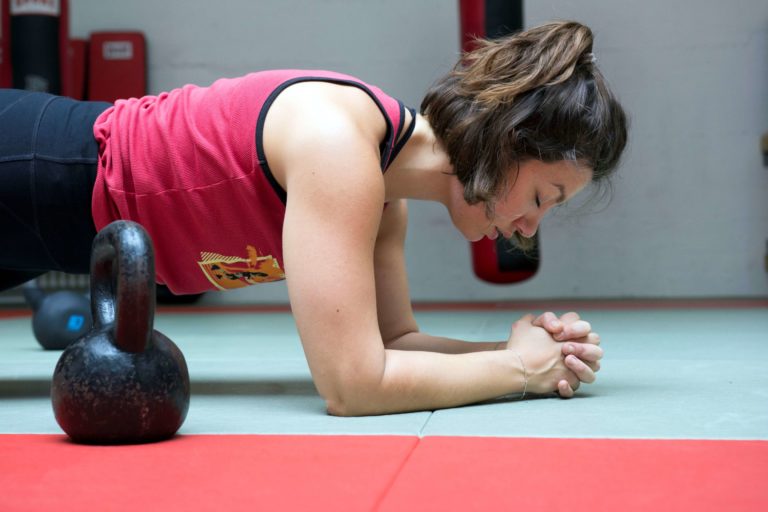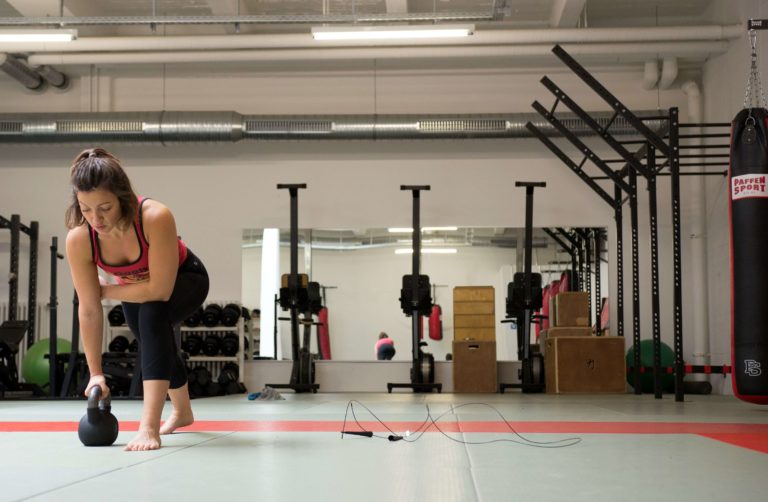With mindfulness, going to the gym can be a lot more enjoyable
If you’re a gym regular then you’re probably familiar with it. You know, those phases when you just want to get the workout done asap so you can get the hell out of there and go chill on the couch? It’s ok, we’ve all been there.
When you really think about it, those phases are trying to tell you something. Because when we get into a routine, and end up on autopilot, we often ignore those messages, and just keep trucking on mindlessly. When we learn to pay closer attention we can get so much more from our training.
This is where mindfulness comes in. It’s really just a fancy word for present moment awareness, with acceptance of our experience rather than judgment. It’s a way of tuning into what’s happening in the moment, and responding accordingly.
Yoga and mindfulness teacher, and movement junky Sarah Baron, 31, was never a big fan of exercise before she began learning yoga and mindfulness. “I went to the gym and worked out, and it was kind of like torture,” she says. “I tried to think about something else more enjoyable just to pass the time until I finished my workout plan. I hated it.
“From the moment I joined my first yoga class this experience started changing,” she continues. “The teacher constantly reminded me to feel my body and anchor my awareness to the present moment. This sparked my interest in the body and changed my approach to working out. I started to look forward to going to the gym.”
Now Sarah trains regularly, and has developed a way to do it mindfully. She says mindful training is about having awareness of your physical movements, thoughts and attitude as you work out. It’s about learning to feel what your body and emotions are telling you, not judging them, and adapting your training moment-by-moment to what you discover. This makes the whole process more enjoyable and fulfilling.
Here are her seven tips to help you bring mindfulness to your training
1. It’s your journey
Going to the gym regularly, it’s easy to forget that you are the ultimate authority of your body and training. Your trainer might be pushing you, which can be motivating, but it doesn’t mean you have to do as you’re told every time. Remember, it’s your fitness journey, it’s your body, and your responsibility to have a healthy relationship with it.
To help cultivate this approach, slow down a little and take pauses so you can tune into what’s going on. Between repetitions and exercises, pause for half a minute and notice how you are doing. You might notice, for example, you feel bored, tired, or stressed, each one offering you insightful information about how your training is going that day. “Learn to tune into your breath and the sensations in your body,” Sarah suggests. “Practicing this way, will train your mind to pay attention and to be more in-touch with your body, which will make you more skilful with training.”
2. Check in before you start
Before you begin your workout, maybe while you’re traveling to the gym, Sarah suggests checking in with yourself. “Be honest with yourself, and take a moment to acknowledge why you are going to workout,” she says. “Does it come from a negative body-image? Do you feel like you need to make up for an unhealthy weekend? Has it become a routine that you makes you feel in control?” Whatever the reason, Sarah says, don’t judge it, but instead observe and acknowledge where it comes from. You can even keep a diary to track how this changes over time. “Observation will bring those deep motives and thoughts to the surface, and it will become easier to act on them,” she says.
3. Create baselines
Baselines give you a way to see where you are at each workout. They are a base number or value for certain activities, for example how many push ups you can do in a row, how many rope jumps in a minute, or whether you’re breathing harder than usual. “Find something that gives you an indication of your energy level and physical capability that day,” Sarah says.
4. Be adaptable
Every day is different. You can learn to loosen your grip on your routine, and to become more responsive to what your check in and baselines are telling you. Allow yourself to change the plan. Maybe you planned to do a cardio workout, but decide to instead spend most of the workout stretching. “The training plan is not the authority – you are,” Sarah reiterates. “You decide the limits.”
5. Avoid distraction
It is common to use the mirror as a way of checking how you are training. This can be handy, but be careful not to get distracted by it. “Instead, move away from the mirror, or close your eyes and try to feel what you are doing,” Sarah advises. Listening to music or podcasts can also be distracting. Try training without them. Bring your attention to which muscles are working, and focus on breathing with the movements. “Training like this will help you cultivate the mind-muscle connection and teach you how to get the most out of your exercise, even when there is no trainer there to push you and correct you,” Sarah says.
6. Train with the breath
Your breath can become a practical tool to help you train better. The power of your exhalations, which engage the core muscles, will generate more power when you lift, for example. Take full breaths to recuperate between rounds. “The breath is a wonderful tool to focus your concentration on,” Sarah says. “Keep your awareness on the breath and you will stay more focused.”
7. Check in at the end
Once you’ve finished your training don’t rush off to the showers. Sit or lie down quietly in the stretching corner and scan through your body, noticing how it feels, for five or 10 minutes. Try to relax your whole body and enjoy the feeling of freshness and wellbeing working out has given you.
Josh Gale
Kiwi journalist tracking adventures great and small


How Yoga can support your health - Sports Tracker Blog
[…] always a purely physical practice. It often includes breathing exercises, meditation, and mindfulness techniques. But these orbit the postural […]